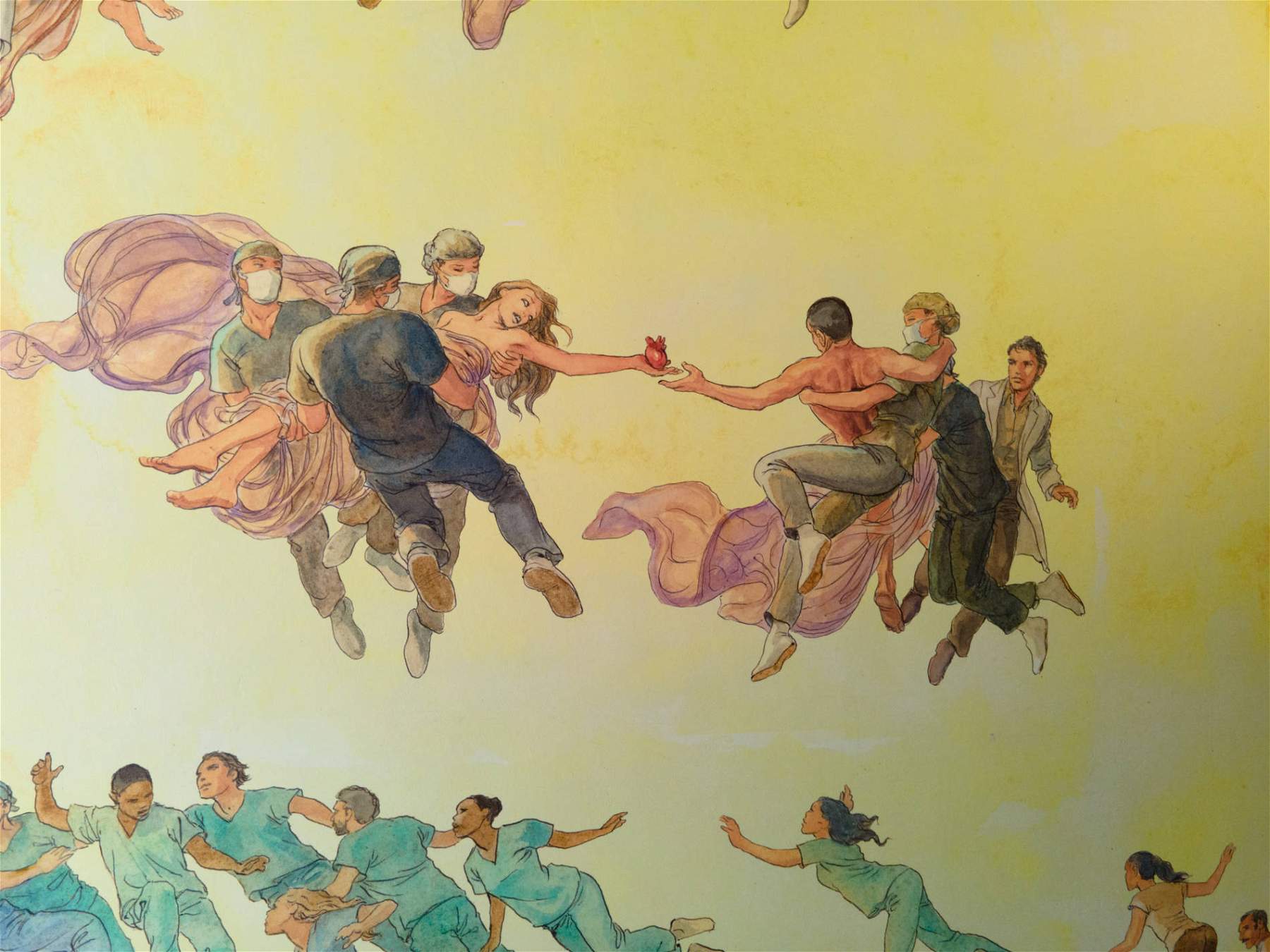Padua, a mural by Milo Manara for the 100th anniversary of the Institute of Human Anatomy
The Institute of Human Anatomy in Padua celebrates its first century of existence with a new mural created by Milo Manara (Luson, 1945), one of Italy’s leading cartoonists and illustrators. On the walls of the building’s monumental staircase is a depiction of the University of Padua’s tradition in the study of human anatomy, ideally linking the historic basement rooms with the modern laboratories on the second floor.
The year 2022 is a year of special anniversaries for the University of Padua: the centenary of the Institute, while the Athenaeum celebrates its Nineteenth Anniversary with a program full of events, lectures and performances. Padua is the cradle of modern anatomy, the chair from which all the discipline’s greatest scientists and scholars have passed, from Bruno da Longobucco to Giovan Battista Morgagni. It was during his years of teaching in the city that the Flemish Andrea Vesalius produced De humani corporis fabrica, the treatise that revolutionized the science of anatomy in 1542. And it was in Padua that the world’s first permanent anatomical theater, still perfectly preserved at the Palazzo del Bo, was completed in 1595. Erected in 1922 to a design by Arezzo architect Guido Fondelli in an area adjacent to the Giustinianeo Hospital, the “Anatomical Institutes” were designed to continue this ancient tradition, with the creation of a new anatomical theater (the Falloppio Hall) and spaces for the Library and Laboratories.
The Mural
Created with the Tattoo Wall technique and developed for about 225 square meters on three flights of stairs and on the ceiling, Milo Manara’s new work uses the language of figurative art to narrate the ancient relationship between the University of Padua and the science of anatomy, sinking its roots in the past and accompanying and projecting the young anatomists of the future towards the new frontiers of research. Tying the different images of the mural together is a “tree of life” inspired by Gustav Klimt’s early 20th century painting of the same name. It is precisely the name of the Viennese painter that also immediately comes to mind when thinking of his famous and now lost Pictures of the Faculties, the cycle of paintings the artist made to decorate the ceiling of the University of Vienna, dedicated to Philosophy, Medicine and Law, respectively.
Giovanni Battista Morgagni (1682- 1771), professor of anatomy is the founder of contemporary pathological anatomy; Antonio Maria Valsalva (1666 - 1723) physician, anatomist and surgeon, favorite pupil of Marcello Malpighi and master of the famous Giovanni Battista Morgagni; Bartolomeo Eustachio (between 1500 and 1510 - 1574), anatomist; Gabriele Falloppio (1523 - 1562), holder of the chairs of anatomy, surgery and botany at the University of Padua; Andrea Vesalius (1514-1564), founder of modern anatomy, who first postulated the need for a comprehensive rewriting of the description of the human body and its parts achieved through the assiduous practice of cadaver dissection; Leonardo da Vinci (1452 - 1519) and Michelangelo Buonarroti (1475 - 1564) are the historical figures represented.
Milo Manara’s work was made possible thanks to the support of the Department of Neuroscience, Protectorate of Artistic, Historical and Cultural Heritage, Protectorate of Building, Protectorate of Education, Building and Safety Area of the University of Padua.
The statements
"In the first wall, I depicted in an allegorical key the phrase Hic est locus ubi mors gaudet succurrere vitae, a wonderful statement that since the entrance to the ancient Anatomical Theater of Palazzo del Bo reminds us that in that place the bodies of the dead were studied in order to learn how to heal the living," explains Milo Manara. "In the second, I took my cue from the famous frontispiece of Andrea Vesalius’ De humani corporis fabrica, adding the figures of other important scientists who taught in Padua over the centuries. The third is instead devoted to new doctors and the exciting possibilities of modern surgery, starting with organ transplantation. These are horizons that ideally project humanity toward a hypothetical eternity, which I have metaphysically illustrated on the ceiling: here is reproduced a starry vault like the one in Giotto’s Scrovegni Chapel, albeit actualized to the vision of modern telescopes, where a primordial Adam and Eve fly, representing the cyclical beginning of life after death."
“The decision to entrust master Milo Manara with the creation of this mural is linked to two main objectives. The first is to reinforce and revive that dialogue between scientific research, dissemination of knowledge and artistic languages that in its eight centuries of history the University of Padua has always cultivated,” says Department of Neuroscience Director Raffaele De Caro. “The second is to create a work that fits perfectly into the context of modern anatomy, a science that has revolutionized the study of medicine and the training of the physician, where the in-depth knowledge of the human body thanks to anatomical studies by dissection has constituted and constitutes the indispensable basis for the development of medical disciplines.”
 |
| Padua, a mural by Milo Manara for the 100th anniversary of the Institute of Human Anatomy |
Warning: the translation into English of the original Italian article was created using automatic tools. We undertake to review all articles, but we do not guarantee the total absence of inaccuracies in the translation due to the program. You can find the original by clicking on the ITA button. If you find any mistake,please contact us.




























